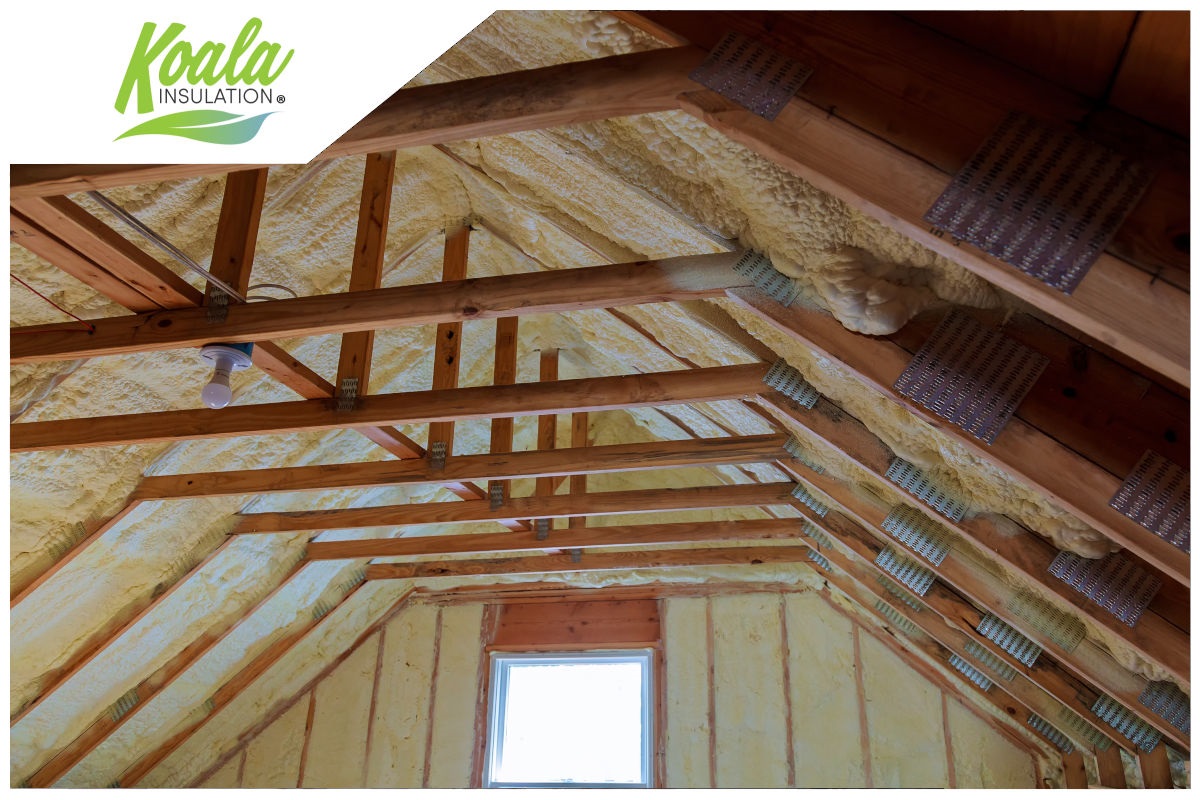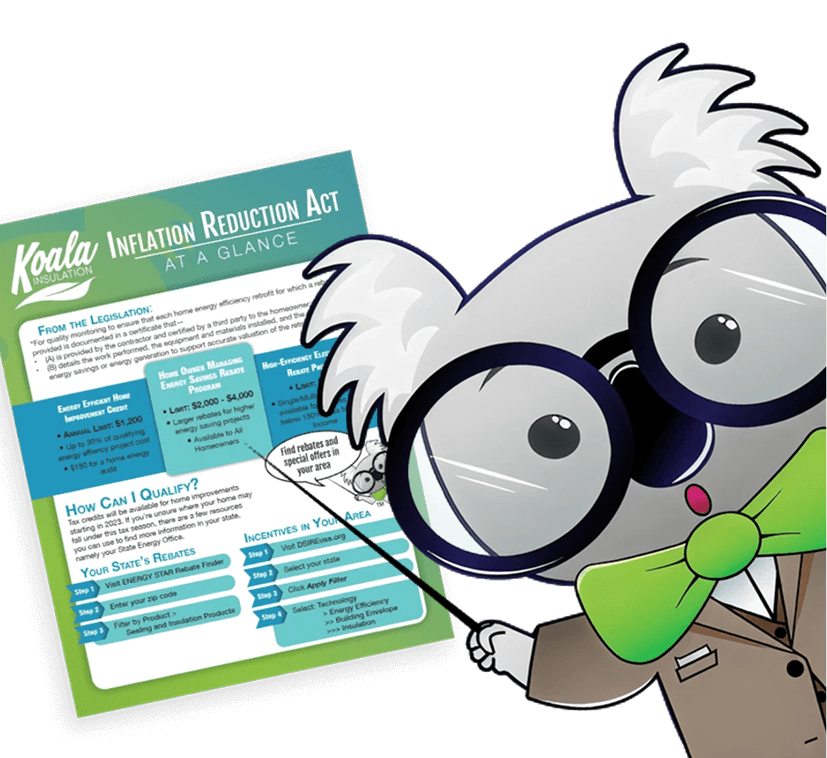How To Lower Your Attic Temperature | Koala Insulation

How To Lower Attic Temperature: 5 Tips From Our Insulation Experts
Whether you appreciate it or not, Kansas City gets the full spectrum of the seasons over the year. Winters can be bone-chilling while summers reach scorching daytime temperatures at least a handful of times. Keeping the lower levels of your home at a comfortable temperature during the hot summer months can be a challenge, let alone keeping your attic cool. Though you may not think about the temperature of your attic space often since you don’t spend a lot of time up there, knowing how to lower attic temperature during the summer is important for avoiding roof damage and paying astronomical utility bills.
With the help of a professional Kansas City insulation company, you can lower the attic temperature in your Overland Park home. In the how-to guide below, we’ll discuss why regulating your attic temperature is so important, as well as offer five steps you can take to achieve a more consistent and comfortable attic temperature.
Why Attic Temperature Matters
You’ve been up to your attic recently to grab that box with the juicer you rarely use, and you were surprised to find out just how hot it was up there. At least it’s not that hot downstairs, right? What harm can a hot attic space do? The answer is—a lot.
The attic air temperature during hot weather should ideally be approximately the same as it is outdoors. It’s perfectly normal for your attic temperature to be somewhere between 10 and 20 degrees Fahrenheit hotter than the outside air, but any higher than this, and you could have a problem on your hands. A hot attic in the summer also indicates that you may have insulation and air leakage issues in the winter, making this a year-round problem. Some of the biggest concerns associated with an attic that reaches temperatures of 130 degrees Fahrenheit or more include:
High Energy Costs
Even if your lower living space is fairly comfortable in the summer, your air conditioning system will work harder to bring down the temperature of your attic. This will result in much higher cooling costs that are necessary. Likewise, in the winter, you’re likely to have the opposite problem—your attic will allow cold air to enter your home and your heating system will work harder to keep your living spaces comfortably warm. Hot attics are a sign of poor energy efficiency, which is not just an environmental concern but also a cause of high utility bills. A lower attic temperature directly translates into energy savings while also helping to keep your house cool.
Damaged Roof Shingles
Does your Overland Park home have asphalt shingles on its roof? These shingles have a protective oil on them to help protect them from the sun and heat, but a hot attic will suck the shingles dry, thereby causing them to deteriorate more quickly and require you to replace your roof shingles sooner than you should have to. If you’ve ever needed a roof replacement before, you know just how costly this service is.
Degradation Of Insulation
Extreme heat can cause some types of insulation to break down more quickly than expected. As insulation deteriorates, it becomes more compressed and less effective at insulating your home. Fortunately, insulation can be topped up using blown-in insulation techniques—and extending the lifespan of your insulation as much as possible keeps more money in your pockets.
How To Lower Attic Temperature In Your Overland Park Home
1. Top Up Your Insulation
Did you know that your insulation optimally performs for only about 15 to 20 years? If you live in an older home or you’re the sole owner of a home that was built a couple of decades ago, it’s probably time to get your attic insulation inspected. Popular types of insulation used in Overland Park homes include:
- Fiberglass insulation
- Cellulose insulation
- Rock wool insulation
- Spray foam insulation
When topping up (or retrofitting) your current insulation, it’s generally recommended that you use blown-in insulation. Unlike batts or rolls that come in premanufactured strips, blown-in insulation allows you to add loose insulation up to your desired thickness in whatever area you need it most. This installation method is also great for filling in irregularly shaped spaces and hard-to-reach areas.
Ensuring that you have adequate insulation for the Overland Park climate is an important first step in learning how to lower attic temperature. Proper insulation levels can be determined by assessing the R-value of your attic. R-value is a measure of insulation’s resistance to thermal transfer or heat flow. The higher the R-value, the greater the resistance will be.
For homes in Missouri, the recommended R-value for attics is about R49. An insulation expert can assess insulation levels around your attic floor joists, walls, vents and electrical fixtures to determine if your R-value is falling short. Using blown-in insulation, they can top up your existing insulation however much is needed to achieve this target R-value. This will help your attic maintain a consistent temperature in both summer and winter.
2. Seal Air Leaks
Our second piece of advice on how to lower attic temperature involves air sealing any potential air leaks. Air leaks are essentially any area in your home where indoor and outdoor air is exchanged. While this will inevitably take place through the opening and closing of windows and doors, any gaps and cracks where air exchange takes place when doors and windows are shut can be a cause for concern.
When temperature differences between indoor and outdoor temperatures are minimal, air leaks aren’t much of a problem. Unfortunately, in Overland Park, these two temperatures are rarely at equilibrium. The exterior air can be considerably colder in the winter and hotter in the summer. Because hot air rises and cold air sinks, pressure changes will drive cool air outside of your home and cause hot air to infiltrate your attic. Sealing unwanted gaps will prevent this air exchange from taking place.
One of the most common questions about spray foam is when this type of insulation should be used. Closed cell spray foam is a great option for sealing air leaks, which may be located in one or more of the following areas:
- Window AC units
- Door and window frames
- Electrical outlets
- Recessed lighting
- Plumbing vents
- Dryer vents
- Fireplace dampers
- Crawl spaces
- And more!
Adding spray foam in hard-to-reach areas of your attic not only provides a high R-value but also blocks air exchange entirely.
Determining the location of the air leaks in your home can be tricky. Ensuring there is caulking around window and door frames and adding weatherstripping to moveable parts on your windows and doors is a great way to eliminate air leaks on your own. However, finding attic leaks is a little more difficult. An insulation expert has the knowledge and expertise to quickly and successfully identify problem areas and fill these areas with spray foam insulation according to principles of best practice and local building codes.
3. Install Attic Vents
Perhaps the most important principle in learning how to lower attic temperature is understanding the impact that proper ventilation has on your attic temperature. This may seem counterintuitive after just telling you that you should seal air leaks around your home, but poor ventilation can lead to a high humidity level and reduced indoor air quality. The key to adequate ventilation is controlling it. Instead of leaving ventilation to air leaks, you’ll want to be intentional about your home’s ventilation design.
There are two main types of ventilation: passive ventilation, which we will discuss in this section, and active ventilation, which will be discussed below. Passive vents refer to those that rely on the natural movement of air to work. They may be exhaust-type (release air) or intake-type (pull air in). Some vent types you may currently have installed on the roof of your home include:
- Gable vents
- Soffit vents
- Over-fascia vents
- Drip edge vents
- Ridge vents
- Off-ridge vents
- Box or louver vents
- Roof turbines
- Cupola vents
It’s a common misconception that homes in a cold climate should not have vents, as they will make the home harder to heat throughout the winter months. As you may have already suspected, exhaust-type vents will not pull cold air into your home, making them a non-issue in areas with cool winter weather like Overland Park.
As a general rule, the number of vents you need in your attic depends on the square footage of the ceiling. You’ll probably want about 1 square foot of ventilation for every 300 square feet of ceiling, but it’s best to hire an insulation company to assess your property and come up with the best solution for you and your home. Likewise, there is such a thing as too much ventilation. Insulation experts can help you find the sweet spot.
4. Install Attic Fans
Passive ventilation solutions are a great addition to any home, but they are reliant on the natural flow of air and differences in air pressure from season to season. If you really want to know how to lower attic temperature, we suggest looking into attic ventilation fans.
Attic fans are considered a type of ‘active’ ventilation because they require a power source to operate. By being reliant on a power source, they of course use more energy, but they’re also more reliable than passive vents. Power vents don’t cost a ton to run on electricity, but if you’re worried about your energy bills, consider installing solar attic fans. These fans are powered using a solar panel and have very quiet operation sounds.
There is certainly an upfront cost associated with passive and active fan installation, but keep in mind that these upfront costs are easily offset by a reduction in your energy bill. They can also add value to your home, making them a great choice for those planning to put their home on the market in the near future.
5. Don’t Neglect The Lower Levels Of Your Home
Now that you know how to lower the attic temperature in your Overland Park home, you’ll need to consider how you can lower the temperature in the lower levels of your home as well. Hot air rises, so any heat produced on your main floor will naturally try to reach your attic. By blocking hot air from accessing the attic, your attic insulation, vents and fans won’t have to work as hard to keep the temperature regulated.
To properly insulate the lower levels of your home and reduce your utility bills further, consider taking the following steps:
- Upgrade your HVAC system. Swapping out your existing air conditioner and furnace for a more energy-efficient model will lower your utility costs.
- Add weatherstripping and caulking. Prevent air from leaking in and out of your home’s windows and doors by caulking and weatherstripping drafty areas.
- Re-insulate areas that have been damaged. Plumbing leaks and pest infestations that happen behind the walls and within crawl spaces can destroy your insulation. Reinsulate these areas as needed.
- Hire an energy auditor. An energy auditor will complete a thorough inspection and assessment of your home to determine areas where greater energy efficiency can be achieved, as well as make projections about how much you’re needlessly overpaying on your energy bills.
Koala Insulation Of South Kansas City Can Help Lower Your Attic Temperature
Now that you know how to lower the attic temperature in your Overland Park home, what are you waiting for? Reduce your energy bills, protect your roofing and insulation and make your home more comfortable by hiring our experienced and talented insulation contractors at Koala Insulation of South Kansas City today.
Our expert team can accurately assess your property and make informed recommendations for insulation removal, replacement and retrofitting, vent installation, solar attic fan installation and air sealing to lower attic temperatures. As professionals, we follow best building practices and building codes down to the letter, so you can rest assured that your service will be done right.
To book a free on-site estimate today, give our office team a call at 816-929-8255 or use our online estimate appointment booking request form. We look forward to helping you lower your attic temperature once and for all!
Find Your Location


Get a quote



